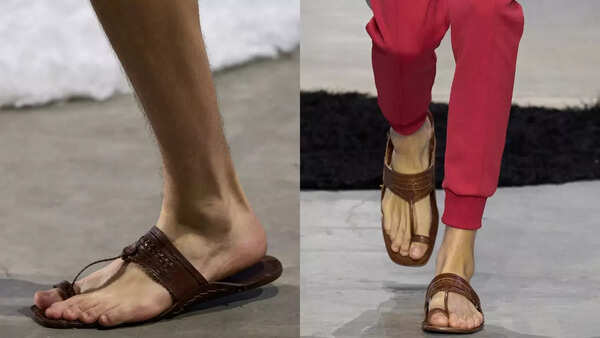Prada has finally recognized the inspiration behind its "new" sandal design from the traditional Kolhapuri chappals of India, following criticism for initially failing to acknowledge the cultural origin.

The controversy arose after Prada showcased its Spring-Summer 2026 men’s collection, which included sandals bearing a striking resemblance to Kolhapuri chappals, a distinctive handmade leather footwear from Maharashtra, India. The fashion house initially described them merely as "leather sandals" in their show notes, omitting any reference to their Indian heritage.
This omission sparked disapproval, with figures like Lalit Gandhi, president of the Maharashtra Chamber of Commerce, Industry and Agriculture, publicly pointing out that Kolhapuri chappals are more than just simple sandals. They represent significant cultural and artisanal heritage, holding a Geographical Indication (GI) tag since 2019, protecting their origin and unique characteristics.
In response to the criticism, Lorenzo Bertelli, head of Corporate Social Responsibility at the Prada Group, sent a letter to Gandhi acknowledging the "inspiration" behind the sandals. Bertelli admitted that the design was indeed influenced by traditional Indian handcrafted footwear, recognizing its "centuries-old heritage." He also clarified that the collection is in its early design phase and has not yet entered production or been offered for sale.
Bertelli further stated Prada's respect for Indian craftsmanship and expressed a desire to explore collaborations with local artisans in the future. This statement marks a potential turning point, suggesting a willingness to engage with and support the communities behind traditional crafts.
While Prada's acknowledgment is a welcome step, the incident highlights the importance of proper credit and collaboration in the fashion industry. Cultural exchange should involve recognizing and supporting the originators of traditional designs, rather than simply appropriating them. If this situation leads to major brands actively promoting and uplifting traditional crafts, it could represent a positive shift towards greater ethical and responsible practices within the fashion world.
Newer articles
Older articles
 Gujarat Cricket Association Set to Debut T20 League in 2025-26 Season
Gujarat Cricket Association Set to Debut T20 League in 2025-26 Season
 Nitish Rana Eyes Delhi Comeback After Disappointing Uttar Pradesh Stint
Nitish Rana Eyes Delhi Comeback After Disappointing Uttar Pradesh Stint
 Prithvi Shaw Admits to Misguided Choices and Lost Focus Amid Career Setbacks
Prithvi Shaw Admits to Misguided Choices and Lost Focus Amid Career Setbacks
 India vs. England: Ex-Selector Slams Fielding Blunders After First Test Defeat; Costly Drops Haunt Team India
India vs. England: Ex-Selector Slams Fielding Blunders After First Test Defeat; Costly Drops Haunt Team India
 Indian Pacer Harshit Rana Released from Squad Ahead of Second England Test Amid Series Setback
Indian Pacer Harshit Rana Released from Squad Ahead of Second England Test Amid Series Setback
 Sachin Tendulkar: 1983 World Cup Victory Fueled My Cricket Dream at Age 10
Sachin Tendulkar: 1983 World Cup Victory Fueled My Cricket Dream at Age 10
 Rishabh Pant's Fearless Batting Style Hailed by Greg Chappell, Compares Him to Gilchrist After Twin Centuries vs. England
Rishabh Pant's Fearless Batting Style Hailed by Greg Chappell, Compares Him to Gilchrist After Twin Centuries vs. England
 Jannat Zubair Reveals Her "Biggest Regret" After Being Eliminated from "The Traitors"
Jannat Zubair Reveals Her "Biggest Regret" After Being Eliminated from "The Traitors"
 Pant Climbs to Career-Best Ranking, Bumrah Retains Top Spot in Latest ICC Test Update
Pant Climbs to Career-Best Ranking, Bumrah Retains Top Spot in Latest ICC Test Update
 Headline:
Bangladesh's Shadman Islam Stands by Teammates After Batting Woes on Day 1 vs. Sri Lanka
Headline:
Bangladesh's Shadman Islam Stands by Teammates After Batting Woes on Day 1 vs. Sri Lanka